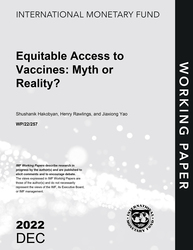
Equitable Access to Vaccines: Myth or Reality?
Equitable Access to Vaccines: Myth or Reality?
READ MORE...
Volume/Issue:
Volume 2022
Issue 257
Publication date: December 2022
ISBN: 9798400229725
$0.00
Add to Cart by clicking price of the language and format you'd like to purchase
Available Languages and Formats
| English |
Topics covered in this book
This title contains information about the following subjects.
Click on a subject if you would like to see other titles with the same subjects.
Economics- Macroeconomics , Economics / General , Demography , COVID-19 , vaccination , access , inequality , vaccination inequality , vaccination rate , vaccine hesitancy , vaccination equality , country distribution challenge , Income inequality , Global , Sub-Saharan Africa
Summary
Fighting the COVID-19 pandemic required vaccinations; however, ending it requires vaccination equality. The progress in vaccinations varies greatly across countries, with low- and middle-income countries having much lower vaccination rates than advanced countries. Initially, the limited vaccine supply was in part to blame for slow pace of vaccinations in low-income countries. But as the supply constraints eased toward the end of 2021, the focus has shifted to in-country distribution challenges and vaccine hesitancy. This paper quantifies the importance of various factors in driving vaccination rates across countries, including vaccine deliveries, demographic structure, health and transport infrastructure and development level. It then estimates the contribution of these factors to vaccination inequality. We show that much of the vaccination inequality in 2021-22 was driven by the lack of access to vaccines which is beyond countries’ control. And although vaccination inequality declined over time, access to vaccines remains the dominant driver of vaccination inequality.
Copyright © 2010 - 2025
Powered by:
AIDC



